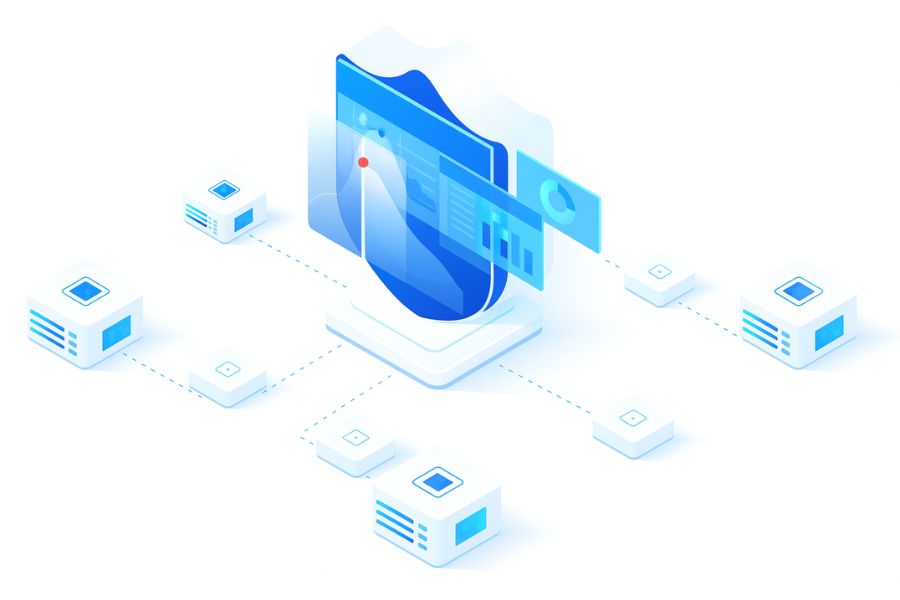
European businesses run on uptime. eCommerce carts, fintech APIs, SaaS dashboards, and gaming match servers all need consistent availability to generate revenue and retain trust. DDoS attacks coordinated floods of junk traffic undermine that promise. In 2025 attackers mix volumetric floods, protocol exploits, and application-layer (Layer 7) surges to bypass legacy firewalls, so preventing DDoS attacks now requires layered engineering, not single devices.
A question that surfaces early is, “Is a dedicated server better than VPS?” For DDoS defense, a dedicated server is superior because its resources aren’t shared and mitigation can be tuned to one tenant, reducing noisy-neighbor risk that exists on VPS nodes. Another early hardware doubt, “What is the best CPU for a dedicated server?” Modern AMD EPYC (7003/9004) and Intel Xeon Scalable (Ice/Granite) deliver high cores and NIC offload support, which matters when filtering tens of millions of packets per second. And yes, “Is dedicated IP faster?” It’s more stable and reputationally cleaner, which improves deliverability and lowers collateral blocking during mitigation, so it’s the right baseline for protected European hosting.
Anatomy of a DDoS attack (and why it beats single-layer defenses)
- Volumetric: UDP/ICMP floods saturate links (100–1,000+ Gbps).
- Protocol: SYN/ACK, RST, fragmentation, or reflection exhaust state tables.
- Application-layer: HTTP(S) GET/POST floods that look like users; they crush login pages, search endpoints, or checkouts.
DDoS mitigation works by diverting traffic to scrubbing centers, applying behavioral and signature filters, and returning clean packets with minimal latency via GRE tunnels or CDN anycast. For apps, application DDoS protection adds WAF+rate-limit+bot management so requests that “look human” but behave like bots are blocked fast.
Where European dedicated servers are vulnerable
- Flat networks (no segmentation) allow lateral spread.
- Under-provisioned uplinks (1 Gbps) buckle under bursts.
- Unprotected DNS invites reflection and cache poisoning.
- No telemetry no NetFlow, no RUM, no synthetic checks means slow detection.
- Patch lag leaves TCP/IP stack bugs exposed.
- No playbooks teams react ad-hoc, prolonging MTTR.
A practical side note people ask: “Which type of server is best?” For regulated, high-traffic EU workloads, a DDoS-protected dedicated server with segmented VLANs and upstream scrubbing is the safest baseline.
Twelve practical answers embedded in the playbook
A. Hardware & IP hygiene
“What is the best CPU for a dedicated server?” Choose EPYC/Xeon with high cores, SR-IOV, and NIC offload (RSS/XDP) to sustain filtering without app slowdowns.
“Do you need a good GPU to run a dedicated server?” No DDoS filtering is network/CPU-bound; add GPUs only for AI/inference or game rendering workloads.
“What is the best server for storage?” For logs/backups, deploy RAID-10 NVMe + ZFS, and isolate storage from edge web nodes to keep attack blast radius small.
B. Provider & IP questions
“Is dedicated IP faster?” It’s more consistent and avoids shared-IP reputation issues during mitigation, improving throughput and email/SMS deliverability.
“What is the best dedicated IP provider?” Pick EU hosts with RIPE-allocated ranges, clean reputation, and in-house abuse/NOC teams Germany/Netherlands are standouts.
“What is the most reliable server?” One sited in Tier III/IV EU facilities with dual uplinks, anycasted scrubbing, and 99.99% SLA on mitigation response.
“Which is the best server in the world?” There’s no universal ‘best’; for DDoS resilience, Frankfurt/Amsterdam/Bucharest dedicated servers with premium scrubbing routinely lead on latency and capacity.
C. Brand comparisons & cost sanity checks
“Does Contabo VPS have GPU?” Some plans do, but GPUs don’t stop DDoS; prioritize upstream scrubbing and Layer 7 controls over graphics hardware.
“How much does Bluehost cost?” Bluehost targets SMB shared/VPS; for European DDoS resilience, choose a provider with EU scrubbing SLAs rather than a budget US-centric host.
“How much does a dedicated server cost?” Expect €90–€180/month entry (1–10 Gbps clean-pipe), €250–€600/month mid-tier with 100–500 Gbps mitigation, and custom pricing for Tbps class.
“Is a dedicated server better than VPS?” Yes during attacks, dedicated isolation and tuned ACLs sustain throughput while VPS neighbors can trigger noisy rate limits.
These answers are now inside the narrative to capture long-tail queries without using a separate FAQ block.
Best practices for preventing DDoS attacks (implementation guide)
Layer 0–1: Physical & network foundation
- Over-provision bandwidth: 10G uplinks with burst capacity; use LACP or dual carriers.
- Anycast + geo diversity: Announce prefixes from at least two EU PoPs (e.g., AMS+FRA) to shorten paths during scrubs.
- BGP communities: Pre-agree blackhole and diversion communities with the ISP for sub-second routing changes.
Layer 2–3: Edge controls
- ACLs before state: Drop obvious garbage (spoofed RFC1918, malformed fragments) in stateless filters to protect firewalls.
- uRPF & TTL filters: Reduce spoofing; cap amplification vectors (NTP/SSDP/Memcached) at the edge.
Layer 4–7: Application DDoS protection
- WAF with adaptive rate-limiting: Answer the first second of a surge with hard caps by IP/ASN/signature; then ease for legitimate cohorts.
- Bot management: Use JavaScript challenges, proof-of-work, or cryptographic tokens; avoid CAPTCHA as a first resort for UX.
- Circuit breakers: degrade non-critical endpoints (search, facets) during spikes to preserve checkout/login.
- mTLS / signed URLs for internal APIs and asset hotlink prevention.
Observability & automation
- Golden signals: p95 latency, saturations, SYN backlog, 429/503 ratios; alert on rates of change, not only absolute thresholds.
- Runbooks: Pre-write Divert to scrub, Tighten WAF, Enable emergency cache rules, Raise autoscale floor.
- Game days: Quarterly attack drills; measure MTTA/MTTR and refine SLOs.
Deep-dive: Application DDoS protection that actually works
Attacks now target stateful operations login POSTs, search suggestions, cart price checks. Protect them by:
- Separating read vs write endpoints with distinct rate limits.
- Token binding (HMAC) so each request proves page lineage.
- Per-user budgets (e.g., 30 writes/min) enforced server-side.
- Cache aggressively: HTML edge caching for catalog pages; serve stale-while-revalidate if origin is pressured.
- Async queues for heavy jobs; never compute at the edge if it can be queued.
A recurring worry “Is dedicated IP faster?” returns here. Stability of a dedicated IP reduces false-positive reputation hits during WAF escalations, so legitimate users reconnect cleanly after a challenge.
Architecture patterns that raise your blast-resistance by 10×
- Clean-pipe with automatic diversion: Provider scrubs first; your edge only sees filtered flows.
- Service mesh + circuit breaking: Prevent thundering herds from overwhelming downstream DBs.
- Multi-region failover: Active/active in two EU metros; DNS health checks push traffic away from a saturated site in <30s.
- DNS hardening: Split-horizon DNS, DNSSEC, and anycast resolvers; ensure your authoritative DNS supports massive QPS with RRL.
Costs that matter (and the ones that don’t)
“How much does a dedicated server cost?” Budget €250–€600/month if you want serious mitigation baked in; below €150 usually means limited clean-pipe capacity.
Track true cost of downtime: revenue/minute + paid traffic lost + SLA penalties + churn uplift over 30 days. For many EU retailers, one 45-minute outage during peak can exceed a full year of premium mitigation fees. That’s why DDoS mitigation is risk transfer, not overhead.
Selecting a European mitigation partner
- SLA: 99.99% uptime, <60s mitigation engagement, documented runbooks.
- Capacity: Proof of >1 Tbps global + clear per-tenant guarantees.
- PoPs: Amsterdam, Frankfurt, Paris, Bucharest at minimum for low EU latency.
- Integration: GRE/BGP, proxy/CDN, or inline; must support your stack.
- Compliance: GDPR, NIS2, ISO 27001; contractual DPAs.
- Support: 24/7 NOC with on-call escalation; show last quarter’s postmortems.
Operational playbooks (what to do in the first 15 minutes)
- Detect unusual SYN, RPS, or 429 growth; confirm with NetFlow.
- Divert via BGP community to scrub; verify RTT and loss.
- Harden WAF: raise per-IP/ASN budgets, enable JS challenges on POSTs.
- Degrade gracefully: serve cached pages, pause non-critical search facets.
- Communicate: status page update in 5 minutes; ETA after mitigation hits.
- Review after action: store signatures, update rules, improve autoscale floors.
During tabletop reviews someone will ask, “Which is the most reliable server?” The one with dual carriers, upstream scrubbing, and proven incident playbooks not merely the highest CPU benchmark.
Country notes (latency & capacity quick wins)
- Netherlands (AMS-IX): exceptional peering; great for pan-EU reach.
- Germany (DE-CIX/FRA): dense enterprise demand; strict compliance culture.
- Romania: competitive pricing, strong network operators, useful for East-EU audiences.
- France: good for application DDoS protection around payments and identity workloads subject to local rules.
Content & storage isolation
- Put static assets on edge CDN with tokenized URLs.
- Store logs in separate storage servers (RAID-10 NVMe/ZFS snapshots) so attack forensics don’t contend with production I/O.
That touches another of your questions, “What is the best server for storage?” Use dedicated storage nodes with ZFS, snapshots, and off-site replication; don’t mix heavy storage with the web edge during attack windows.
Bringing it together
When stakeholders ask, “Which type of server is best?” and “Which is the best server in the world?” the right response is pragmatic: the best server is the one architected for your users, with upstream scrubbing, Layer-7 controls, dual carriers, and rehearsed playbooks typically a DDoS-protected dedicated server in a major EU metro.
Security that scales with your growth
Preventing DDoS attacks requires more than a single appliance—it demands a holistic strategy. European businesses need capacity at the edge, upstream clean-pipe services, and robust application DDoS protection to shield APIs, logins, and transactions. Combined with automated monitoring, bandwidth over-provisioning, and disciplined response playbooks, these measures form a resilient defense model. The result is not only reduced downtime but also stronger customer trust and regulatory compliance. By adopting layered DDoS mitigation, businesses safeguard revenue, protect SLAs, and scale confidently, even as attackers become more advanced in 2025.

